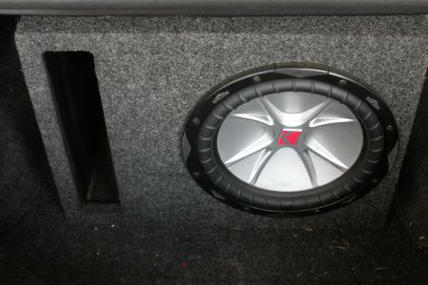Power has an addictive quality. Whether in politics or car audio, the more power people get, the more they usually want. Just as power in politics helps you get what you want, power in a car audio system helps you get the sound you want. And in both scenarios, you'll never be satisfied, and you'll always crave more.
Powering Up With an Amplifier
An audio signal generated by a head unit doesn't have enough power to drive car speakers. The signal has to be amplified before it can move a speaker's voice coil and subsequently the speaker's cone, and the larger the cone, the more power is needed to move it. That's why tweeters require very little power and subwoofers require a lot.
Separate or outboard amplifiers are, of course, also limited to the current supplied by the car's charging system. But they have dedicated switching power supplies that are too large to fit inside a head unit and generate too much heat to be installed in a vehicle's dash. A switching power supply significantly boosts the voltage available from the car's charging system to provide higher power to the speakers.
Using the amplifier built into a head unit may be fine for smaller systems, and you can even use it to power smaller speakers in large systems that also include outboard amplifiers. But without a separate amplifier, your system will never achieve significant volume levels and high performance.
The power from a head unit's built-in amplifier isn't as clean as that of a high-quality outboard amplifier and typically has higher distortion, particularly at high volume levels. This means that your music won't sound as good with only head-unit power as opposed to using a separate amp. Therefore, separate power amplifiers not only pump up the volume, but also improve the quality of the sound.
Knowing How Much Power is Enough
So you know you need power, and you don't plan to go into politics. When shopping for an amplifier, the question becomes, "How much power is enough?" This is a question only you can answer. In this section, I take a look at some parameters that will help you decide how much power is right for you and your system.
You'll need at least enough power to capably drive all of the speakers in your system. Speakers come with power ratings, usually given as maximum (sometimes called peak power), which is the most power a speaker can safely handle, and nominal, which is how much a speaker can continuously handle. A good rule of thumb is to add up the amount of nominal power all of the speakers in your system will need and add 10 percent to arrive at how much power you will need. This is for listening to music at an average volume, however. If you will be cranking it way up, you'll need more.
Sensitivity Training
Manufacturers obtain the sensitivity spec by supplying a speaker with 1 watt of power and measuring the output in decibels (dB), with a microphone 1 meter away. Hence, a sensitivity spec usually looks like this:
91 dB (1watt/one meter)
This means that the speaker puts out 91 dB of sound-pressure level (SPL) measured 1 meter away when fed a 1-watt signal.
In addition to matching the amplifiers to your speakers, you'll also need to match the amplifier to your car's charging system. One way to do this is to add up the current draw of all of your amplifiers, and then find out how much current your alternator provides. You can sometimes find this info in your car owner's manual or on the alternator itself. If your amplifiers draw more current than your alternator can produce, you need to back down on the amount of amplifier power you add to your car or beef up your charging system, which is expensive.
Keep in mind that your car's alternator is designed to supply all of the car's electrical components with enough power, plus have some in reserve. Adding a low-powered amplifier or two and listening at moderate to high volumes will not have an adverse effect on the car's charging system. But adding multiple mega-watt amps and constantly blasting bass will. Keep this in mind when figuring out how much amplifier power you'll add to your car's audio system.
As mentioned earlier, music is dynamic, with loud and soft parts. Therefore, your amplifiers won't be continuously drawing their peak-current demands. During loud passages, such as when a bass note hits or during a high-pitched rock guitar solo, amplifiers send more power to speakers. At these times, an amplifier puts out peak power - and your car's electrical system is maxed out.
Vehicle Noise
Another factor that has a bearing on how much amplifier power you need is how noisy your vehicle is. If you drive a quiet luxury car like a Lexus or Cadillac, you may not need as much power as someone who drives a Jeep, pickup, convertible, or sports car.
How loud you like to play music is another consideration. If you listen to, say, smooth jazz at moderate volume levels, you can get by with less power than if you listen exclusively to rap and rock. If you're building a car audio system to get as loud as possible or even enter SPL (sound pressure level) competitions, you'll need much more amplifier power as well.
The Diminishing Returns of Increased Power
Acoustical power is measured on a logarithmic scale. This means that you don't get twice as much sound pressure when you add twice as much power. In fact, doubling the power gives you much less than double the sound pressure. All things being equal in a given audio system, a doubling of amplifier power represents approximately a 3 dB increase in volume. To put this in perspective, say that with 250 watts, your system will play at 100 dB of SPL. With 500 watts, it will play at 103 dB. Doubling the power from 500 to 1,000 watts only increases SPL output to 106 dB. As you can see, you can quickly reach a point of diminishing returns on money invested in power amplifiers. And, as in politics, power doesn't come cheap.
A substantial increase in power not only drains your wallet, but also your car's electrical system. As you increase amplifier power in your system, you increase the load on your car's electrical system, which was never designed to handle a bunch of car audio amplifiers in the first place. Some people with mega-watt systems resort to adding extra batteries and high-output alternators, although that's only for the most extreme systems. High-watt systems also need larger cabling and more fusing, which increases the system's cost and complexity.
For most people, a well-designed system with around 400 to 800 watts will be sufficient to create good, clean sound. Power will be split between the subwoofers and the rest of the speakers, with the lion's share going to power-hungry subwoofers and much less going to the midranges and tweeters. In a system that includes, say, 600 watts of amplification powering four midranges and tweeters and a single 12-inch subwoofer, you may have 150 watts (300 total) going to the two pairs of midranges and tweeters and the remaining 300 watts powering the subwoofer.
Power Per Channel
All amplifiers are measured in watts per channel. A watt is a means by which electrical power is measured, and amplifiers are rated by the number of watts they can deliver per channel. (Think of a channel as left and right speakers when listening to a stereo recording.) A two-channel or stereo amplifier with a rating of 50 watts per channel provides 50 watts into each of the right and left channels.
From Car Audio for Dummies, copyright © 2008 by John Wiley & Sons, Inc., Hoboken, New Jersey. Used by arrangement with John Wiley & Sons, Inc.










